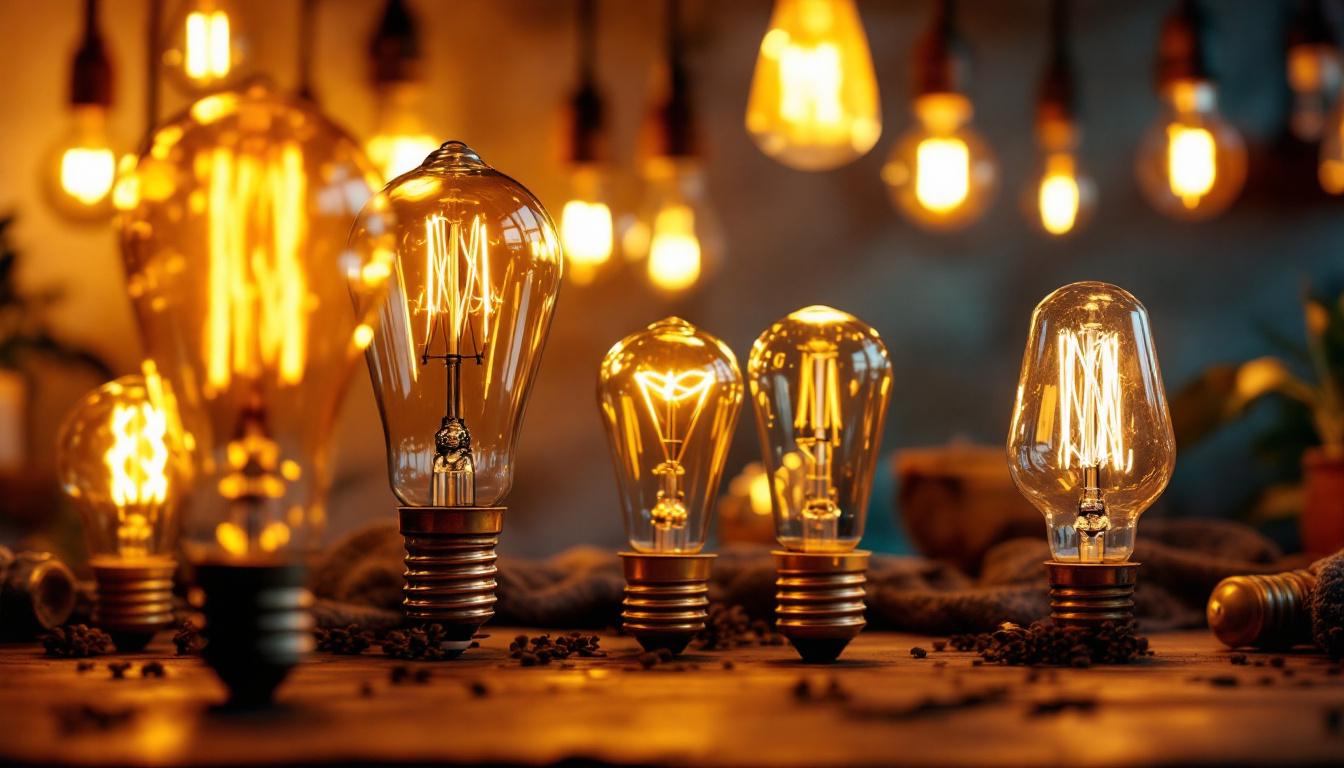
In the rapidly evolving world of lighting technology, LED light bulbs have emerged as a game-changer for both residential and commercial applications. For lighting contractors, understanding the various types of LED bulbs available is essential for providing clients with the best solutions tailored to their needs. This guide explores the different types of LED light bulbs, their applications, and factors to consider when making a selection.
Before diving into the specific types of LED light bulbs, it’s crucial to grasp the fundamentals of LED technology. LED, or Light Emitting Diode, is a semiconductor device that emits light when an electric current passes through it. Unlike traditional incandescent or fluorescent bulbs, LEDs are more energy-efficient, have a longer lifespan, and produce less heat. This efficiency is not just a matter of saving on electricity bills; it also contributes to a reduced carbon footprint, making LEDs a more environmentally friendly choice.
LED technology has advanced significantly over the years, leading to a wide variety of options available on the market. This evolution has made it possible for contractors to offer clients a range of lighting solutions that suit diverse applications, from residential homes to large commercial spaces. Innovations in LED design have also led to the development of smart lighting systems that can be controlled remotely, allowing users to adjust brightness and color temperature according to their preferences and needs.
One of the most compelling reasons to choose LED bulbs is their energy efficiency. These bulbs consume significantly less power than traditional lighting options, which translates to lower energy bills for clients. Additionally, LEDs have a lifespan of up to 25,000 hours or more, reducing the frequency of replacements and maintenance costs. This longevity not only benefits homeowners but also commercial establishments, where lighting can be a substantial part of operational expenses.
Understanding the energy efficiency ratings and lifespan of different LED bulbs can help contractors make informed decisions when recommending products to clients. This knowledge not only enhances customer satisfaction but also positions contractors as knowledgeable experts in their field. Furthermore, many LED products now come with warranties that reflect their durability, providing an added layer of assurance for clients. As the market continues to evolve, staying updated on the latest advancements in LED technology can empower contractors to offer the most effective and innovative solutions, ensuring that their clients receive the best value for their investment.
LED light bulbs come in various shapes, sizes, and functionalities. Each type serves a specific purpose and can be chosen based on the lighting needs of a particular space. Below are some of the most common types of LED light bulbs that contractors should be familiar with.
The A19 bulb is one of the most commonly used LED bulbs in residential settings. It features a classic shape that fits standard light fixtures and is available in various wattages and color temperatures. A19 bulbs are ideal for general lighting applications, such as in living rooms, bedrooms, and kitchens.
When selecting A19 bulbs, contractors should consider the desired brightness, measured in lumens, and the color temperature, which can range from warm white to cool daylight. This flexibility allows contractors to cater to the specific ambiance preferences of their clients. Additionally, A19 bulbs are often available with smart technology features, allowing homeowners to control their lighting remotely or set schedules, further enhancing convenience and energy efficiency.
PAR (Parabolic Aluminized Reflector) and BR (Bulged Reflector) bulbs are designed for directional lighting applications. These bulbs are commonly used in recessed lighting, track lighting, and outdoor floodlights. They provide focused beams of light, making them ideal for highlighting specific areas or features in a space.
When choosing PAR or BR bulbs, it’s essential to consider the beam angle, which affects how wide or narrow the light spreads. A narrow beam angle is suitable for accent lighting, while a wider beam angle is better for general illumination. Furthermore, these bulbs often come with different wattage options, allowing for energy-efficient lighting solutions that can significantly reduce electricity bills while still providing the necessary brightness for various tasks.
Candelabra bulbs, often used in chandeliers and decorative fixtures, add a touch of elegance to any space. These bulbs come in various shapes, including flame and globe styles, and are available in both standard and dimmable options.
Contractors should be mindful of the aesthetic preferences of their clients when recommending candelabra or decorative bulbs. The right choice can enhance the overall design of a room while providing the necessary lighting. Additionally, many decorative LED bulbs now feature vintage designs with filament-like appearances that mimic traditional incandescent bulbs, appealing to those who appreciate a classic look without sacrificing energy efficiency. This blend of style and functionality makes them a popular choice for both modern and traditional interiors alike.
As technology continues to advance, smart LED bulbs have gained popularity among homeowners and businesses alike. These bulbs can be controlled remotely via smartphones or smart home systems, allowing users to adjust brightness, color, and schedules with ease.
For contractors, offering smart LED solutions can set them apart from competitors. Understanding the various smart lighting systems available, including compatibility with different platforms like Amazon Alexa or Google Home, is essential for providing clients with tailored solutions.
Smart LED bulbs offer numerous benefits, including energy savings, convenience, and enhanced security. By allowing users to control their lighting remotely, these bulbs can help reduce energy consumption by ensuring lights are turned off when not needed.
Additionally, smart bulbs can be programmed to simulate occupancy, providing an added layer of security for homes and businesses. Educating clients about these features can help contractors promote the advantages of smart lighting solutions effectively.
When selecting LED light bulbs for clients, several factors should be taken into account. Understanding these considerations can help contractors make informed recommendations that align with their clients’ needs and preferences.
Color temperature is a critical aspect of lighting design. Measured in Kelvin (K), it indicates the warmth or coolness of the light emitted by a bulb. Lower Kelvin values (around 2700K) produce warm white light, while higher values (5000K and above) yield cool daylight effects.
Contractors should assess the intended use of the space when recommending color temperatures. For example, warm white light is often preferred in living areas for a cozy atmosphere, while cooler temperatures are suitable for workspaces where clarity and focus are paramount.
Brightness is another essential consideration when selecting LED bulbs. Unlike wattage, which indicates energy consumption, lumens measure the amount of light produced. Clients may be accustomed to thinking in terms of watts, so educating them about lumens can help clarify their options.
Contractors should provide guidance on the appropriate lumen output for different spaces. For instance, a living room may require around 1,500 to 3,000 lumens, while a kitchen or workspace may need more, depending on the tasks performed in those areas.
Many clients appreciate the ability to adjust lighting levels to suit different activities or moods. When recommending LED bulbs, it’s crucial to ensure they are compatible with existing dimmer switches. Not all LED bulbs work seamlessly with dimmers, so contractors should advise clients on the best options to avoid flickering or buzzing.
By providing this information, contractors can enhance the overall lighting experience for their clients, ensuring they achieve the desired ambiance in their spaces.
Proper installation is key to maximizing the performance and lifespan of LED bulbs. Contractors should follow best practices to ensure that clients receive the full benefits of their lighting choices.
Before installing LED bulbs, it’s essential to verify that the fixtures are compatible with the selected bulbs. Some fixtures may require specific types of bulbs, such as those designed for enclosed spaces or those with particular wattage ratings. Ensuring compatibility can prevent issues like overheating or reduced performance.
Contractors should also take note of the fixture’s design and purpose. For example, recessed lighting may require specific beam angles to achieve the desired effect, while pendant lights may benefit from decorative bulbs that enhance the overall aesthetic.
When installing LED bulbs, contractors should pay attention to the wiring and electrical components of the fixtures. Ensuring that the wiring is up to code and capable of handling the electrical load is crucial for safety and performance.
Additionally, using appropriate wattage ratings for the fixtures can prevent overheating and prolong the lifespan of the bulbs. Educating clients about the importance of these considerations can help them appreciate the value of professional installation.
Choosing the right LED light bulbs is a critical aspect of any lighting project. By understanding the various types of LED bulbs available, their applications, and the factors to consider, lighting contractors can provide clients with tailored solutions that meet their specific needs.
From standard A19 bulbs to smart LED options, the range of choices allows contractors to create effective lighting designs that enhance both functionality and aesthetics. By staying informed about the latest advancements in LED technology, contractors can position themselves as trusted experts in the field, ensuring client satisfaction and successful project outcomes.
Ready to elevate your lighting projects with the best LED solutions on the market? Look no further than LumenWholesale, where we specialize in providing contractors with spec-grade lighting products at unbeatable wholesale prices. Say goodbye to local distributor markups and hello to our extensive selection that meets the highest industry standards. With LumenWholesale, you’ll enjoy the convenience of bulk buying with free shipping, ensuring you get premium lighting at the best value — without hidden fees. Don’t compromise on quality or affordability. Discover our wholesale lighting options today and bring unparalleled quality and efficiency to every project.

Discover the essential guide for lighting contractors on old style light bulbs.

Discover the key factors that distinguish top lighting contractors when choosing light kits for ceiling fans.

Discover how solar lamps are revolutionizing the lighting industry, offering eco-friendly solutions and cost-effective options for contractors.

Illuminate your projects with confidence! Discover expert advice and innovative tips tailored for lighting contractors in our comprehensive guide to exterior lamps.